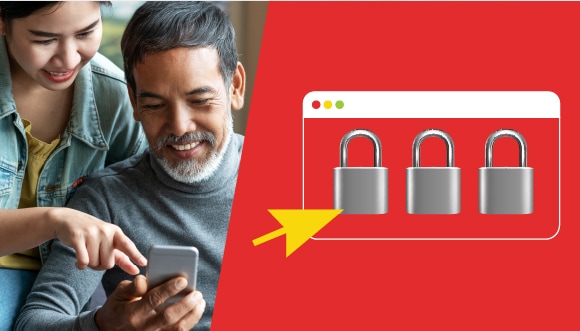At Get Cyber Safe, our goal is to make cyber security easy and simple for all Canadians. We believe that with the right advice and guidance, anyone can take control of their cyber safety. This blog post may be especially useful for older adults, who we define as Canadians over the age of 50, but we believe that the information could help anyone at any age, in any stage in their cyber security journey. 
If you’ve spent time as your parents’ or grandparents’ personal tech support specialist, you’re not alone. According to Get Cyber Safe’s 2020 public opinion survey, nearly one-third of Canadians have helped others with their cyber security — 61% of them have assisted their parents and another 17% have helped their grandparents stay safe online.
But sometimes, it can be hard to know how to explain cyber security to someone whose security knowledge may not be as up to date as yours. How do you explain threats without making the internet sound, well, threatening? We’ve put together a few tips for the next time you’re assisting the older adult in your life with their online security.
Focus on what matters to them
When explaining the basics of cyber security to someone who’s not sure about it, there’s no need to get into the nitty gritty details. If you’re helping an older adult get cyber safe, stick to teaching them about preventing the threats they are more likely to encounter, like phishing and smishing scams, malware, identity theft and romance scams.
Be understanding and consider the experience the older adult you’re helping already has with technology. They probably know a lot more than you think, but they might not be sure what to do when things go wrong! You can share the information that will be the most useful for them.
If the person you’re helping has been the victim of a cyber threat in the past, talk to them about how it happened and let them know where they can make different choices next time to stay safe.
Keep it simple
The more comfortable we are online, the easier it is to keep ourselves safe. Help older adults stay safe online by making the things they’re doing easier. For example, if your dad is having a tough time remembering the secure passwords you helped him create, show him how to use a password manager to keep them safe. If he’s not comfortable with that, print out the Get Cyber Safe password organizer so he can write them down to keep in a safe location for when he needs them.
You may also want to direct the older folks you’re helping to our simple resources for spotting a phishing message, like The 7 Red Flags of Phishing or this flowchart to check if banking emails are legitimate. You can also show them these sample scam emails so they can see examples of phishing in real life. Encourage them to treat these tools as a checklist when they receive an email so they can spot a phishing message in just a few quick steps.
Conclusion
It can be difficult for anyone to keep up with all the new cyber threats. But with the right knowledge and tools at your disposal, you can help the older adults in your life get cyber safe and protect themselves from threats online.